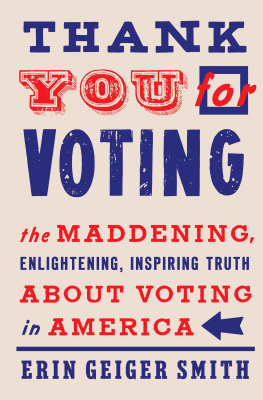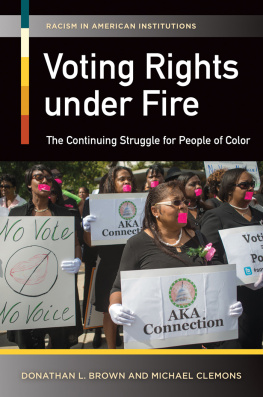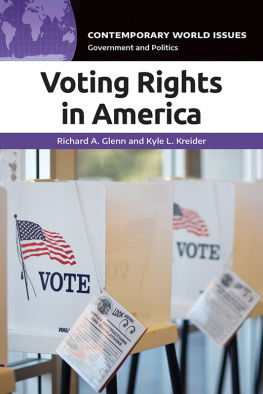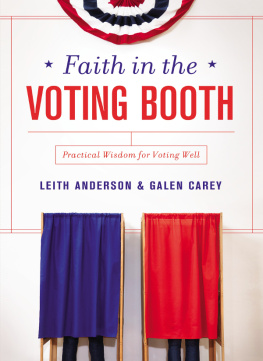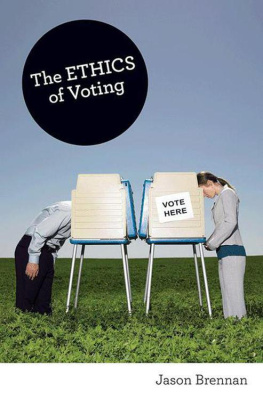Erin Geiger Smith - Thank You for Voting: The Maddening, Enlightening, Inspiring Truth About Voting in America
Here you can read online Erin Geiger Smith - Thank You for Voting: The Maddening, Enlightening, Inspiring Truth About Voting in America full text of the book (entire story) in english for free. Download pdf and epub, get meaning, cover and reviews about this ebook. year: 2020, publisher: HarperCollins, genre: Politics. Description of the work, (preface) as well as reviews are available. Best literature library LitArk.com created for fans of good reading and offers a wide selection of genres:
Romance novel
Science fiction
Adventure
Detective
Science
History
Home and family
Prose
Art
Politics
Computer
Non-fiction
Religion
Business
Children
Humor
Choose a favorite category and find really read worthwhile books. Enjoy immersion in the world of imagination, feel the emotions of the characters or learn something new for yourself, make an fascinating discovery.
- Book:Thank You for Voting: The Maddening, Enlightening, Inspiring Truth About Voting in America
- Author:
- Publisher:HarperCollins
- Genre:
- Year:2020
- Rating:3 / 5
- Favourites:Add to favourites
- Your mark:
- 60
- 1
- 2
- 3
- 4
- 5
Thank You for Voting: The Maddening, Enlightening, Inspiring Truth About Voting in America: summary, description and annotation
We offer to read an annotation, description, summary or preface (depends on what the author of the book "Thank You for Voting: The Maddening, Enlightening, Inspiring Truth About Voting in America" wrote himself). If you haven't found the necessary information about the book — write in the comments, we will try to find it.
Erin Geiger Smith: author's other books
Who wrote Thank You for Voting: The Maddening, Enlightening, Inspiring Truth About Voting in America? Find out the surname, the name of the author of the book and a list of all author's works by series.
Thank You for Voting: The Maddening, Enlightening, Inspiring Truth About Voting in America — read online for free the complete book (whole text) full work
Below is the text of the book, divided by pages. System saving the place of the last page read, allows you to conveniently read the book "Thank You for Voting: The Maddening, Enlightening, Inspiring Truth About Voting in America" online for free, without having to search again every time where you left off. Put a bookmark, and you can go to the page where you finished reading at any time.
Font size:
Interval:
Bookmark:
Contents
For Bryan
For Mom
Contents

League of Women Voters Get Out the Vote Wagon, Anne Arundel County, Maryland, 1940s (Courtesy of League of Women Voters)
N obody will ever deprive the American people of the right to vote except the American people themselvesand the only way they could do that is by not voting.
President Franklin D. Roosevelts quote resurfaces every election season to encourage voter participation. It conjures an image of an American flag waving gracefully against a cloudless sky and reminds us of our personal power to steer the country on health care, education, the economy, climate change, and everything else that matters. Voting is one of Americas greatest sources of pride. It also exposes our greatest contradictions.
The United States has a voting problem: not enough of us do it.
To solve that problem, and it is solvable, we need to better understand our voting history and how it affects turnout today. Making that connection allows an honest evaluation of flaws in our electoral system. But it also means celebrating creative and effective get-out-the-vote efforts, highlighting the importance of adding fun and friendship to the process, and learning about solutions that make it easier to register and vote. Taking time to break down topics that stump even the most educated voters will empower us to enter the voting booth confident in our choices all the way to the bottom of the ballot.
The goal of this book is to provide the information necessary for you to vote, to convince you of the importance of voting in every election, and to encourage you to recruit the people youre closest with to join you. (Yes, social-media-close counts as close.)
Roosevelts quote is the Instagram version of the countrys more nuanced reality. The longest-serving president delivered the sound-bite in a 1944 campaign-season address from the White House, at a time when states deprived many American citizens of the right to vote and had just years earlier barred many more.
The same year as Roosevelts speech, the U.S. Supreme Court ruled against the Texas white primary, which kept black people from voting. True access to the polls for African Americans in the South was more than twenty years away. Many Native Americans had more than a decade ahead of them in their struggle for voting rights; some Asian immigrants were still permanently barred from voting. Women had voted nationwide for less than twenty-five years.
Roosevelt knew all of this. He began his speech on that patriotic note but soon acknowledged all the ways this initial image of America was a flattering filter. The right to vote must be open to our citizens irrespective of race, color or creed... The sooner we get to that basis of political equality, the better it will be for the country as a whole.
Roosevelt wanted to promote our ideals about voting and bury, even if just for a moment, discussion of the work still needed to approach political equality. Ignoring this bigger truth is a habit Americans have developed into an art form.
After the most recent presidential election and the countrys contrasting reactions of jubilation and despair, I couldnt stop thinking about the power in voting, and what it means in a country that appears so divided on cornerstones of democracythe First Amendment, the rule of law, immigration, whether watching eighteen hours a day of cable news is a good idea.
I live in New York City and am a journalist. Ive written articles on entrepreneurs at the top of their game, tech executives trying to survive Supreme Court battles, artists creating postcards with political messages, and the very real struggle to complete Infinite Jest. But my own story begins in Liberty, Texas, its population now just shy of ten thousand people. It was an even smaller town when I lived there. Towering oak trees shade the three-story limestone courthouse in a quintessential town square. Its Libertys seventh courthouse, the first built of hewn logs when Texas was still part of Mexico. The town burger joint is across the street, and multiple churches are within walking distance, their steeples among the tallest things in town.
I feel a strong connection to both Manhattan and my hometown, but around election time they seem like different universes. Liberty County is overwhelmingly Republican, while my current neighborhood votes heavily in favor of Democrats. At the end of 2016, it felt like New York and other major cities had long lived with the idea that their opinions were the only ones that mattered, while Liberty had finally banded together with its like-minded small towns to turn an annoyed whisper into a thunderous shout.
The two places very different motivations for supporting candidates are clear to me. And while our fear that we wont be represented, that our wants and needs will be ignored if our candidate doesnt win, is emblematic of how divided we are, it also highlights the importance of electing politicians willing to consider the concerns of constituents who voted for somebody else.
Despite the constant political noise about our strong feelings, our hopes, and our abiding deference to the idea of majority rule, so many of us are silent come Election Day. Even with a recent uptick in turnout in 2018, those who do vote cant pick up the slack for their peers who dont.
Each generation votes at lower rates than the one older, and at times about a quarter of young adults speak for all of them. The same downhill slide holds when it comes to education levels. Adults with postgraduate degrees love to votearound 80 percent turnout for presidential elections. But then the drop starts and doesnt stop, with Americans who didnt graduate high school sometimes voting at rates two times lower. There are racial disparities in who votes, too. While African Americans and white people vote in similar numbers in presidential elections, a significantly lower percentage of Hispanics and Asian Americans participate.
Each person who does vote is motivated by his or her own unique combination of issues and histories. Loyalty to a political party gets some to the polls; others vote when their union tells them to, or when their favorite TV commentator does. The most predictable voters do it out of habit, driven by civic duty as much as by who is on the ballot. Every election offers young people the thrill of voting for the first time. Some people cast a ballot to honor grandparents who never had the privilege.
A friend recalls adults in Sunday school who said that finding candidates who would outlaw abortion was a top priority. An Ohio autoworkers vote in the last presidential election was earned by the person he thought could save the livelihood of his struggling town. Those despairing over the environment are interested only in vocal proponents of greener policies. Its the economy, stupid has become a political trope, but impact on ones own wallet is the driving factor for many.
The Supreme Court. The Second Amendment. Minimum wage. The opioid crisis. The motivations are countless, but they all result in one act: voting. If others who share your views stay home, your voice isnt optimized. Well never know what the country truly wants and needs unless more of us participate.
This book is divided into three sections. The first explains how and when different groups of AmericansAfrican Americans, women, and young people, among othersgot the right to vote. It also looks at current examples of voter suppression, and methods some states use to increase registration and turnout. The second section takes you inside innovative get-out-the-vote movements to demonstrate how their participants actions and attitudes can be replicated to boost turnout in your own peer or work group. And the final section provides straightforward explanations of vexing voting topicsgerrymandering, political news and polling, and the Electoral College. The last pages feature checklists to help you prepare to vote and spread the word.
Font size:
Interval:
Bookmark:
Similar books «Thank You for Voting: The Maddening, Enlightening, Inspiring Truth About Voting in America»
Look at similar books to Thank You for Voting: The Maddening, Enlightening, Inspiring Truth About Voting in America. We have selected literature similar in name and meaning in the hope of providing readers with more options to find new, interesting, not yet read works.
Discussion, reviews of the book Thank You for Voting: The Maddening, Enlightening, Inspiring Truth About Voting in America and just readers' own opinions. Leave your comments, write what you think about the work, its meaning or the main characters. Specify what exactly you liked and what you didn't like, and why you think so.

